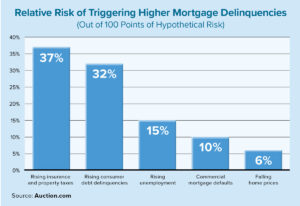The national homeownership rate in second-quarter 2018 represented one of the first year-over-year increases since 2006 in the share of U.S. households that own their homes. Yet, real estate investors in 2019 are still expecting an inflated demand for apartment living. This is partially due to an ongoing shift in demographic trends, which is boosting the need for a strong multifamily-housing market.
Many developers assume millennials are driving the increased preference for renting. Although there are generational differences in who is renting rather than buying, members of every generation are now choosing the rental lifestyle due to its inherent flexibility. Both younger and older Americans are charting a preference to rent, rather than buy, a home.
The long-term outlook for multifamily construction shows the preferences of baby boomers and millennials alike are causing an associated shift in demand from single-family to multifamily living options. By the end of this year, multifamily construction projects are expected to peak at a rate nearly two-thirds higher than anything seen during the 1990s and 2000s.
For age groups at both ends of the spectrum, the demand for better amenities, more flexibility and a close connection to cities are driving a real estate race among developers to create the next generation of apartment living. Commercial mortgage brokers who work with these developers should be aware of the factors that are driving demand for multifamily housing.
Ditching white picket fences
The housing preferences of baby boomers have been disrupting the multifamily sector for some time, according to a 2017 CNBC report. This generation is selling their big suburban homes, which are often empty nests, and turning the key on maintenance-free apartment living.
There is an increased need for mortgage brokers and borrowers to recognize the key influence of this generation upon multifamily housing trends, since the share of older Americans is expected to increase. In 2050, the number of Americans aged 65 and older is projected to be 88.5 million, more than double the population of 40.2 million in 2010, according to the U.S. Census Bureau. This generation is the fastest-growing group of renters, especially in the senior-housing and assisted-living spaces.
Additionally, millennials prefer renting rather than owning for a variety of reasons, including personal preference and economic disadvantages. A contributing factor that explains why the homeownership rate for millennials — the largest generation in U.S. history — is lower than that of their parents and grandparents is high levels of student-loan debt among younger households.
For every 10 percent increase in student-loan debt a person holds, their odds of becoming a homeowner drops 1 to 2 percentage points during the first five years after they leave college, according to a Federal Reserve study on the effects of student loans upon access to homeownership. Each of these factors compound quickly and should matter to multifamily developers, as every 1 percent drop in the homeownership rate creates a need for 1 million new rental units.
Upgrading amenities and services
Baby boomers are altering the traditional notion of the American dream. Although it’s not unusual for empty nesters to downsize, that process has historically meant they are buying smaller homes or condominiums. Now, however, an increasing number of baby boomers want to rent rather than own.
Baby boomers are now opting to sell their large, suburban homes when they become empty nesters and instead live in rental properties with full amenities. In this way, they are avoiding tasks such as lawn mowing, snow shoveling, and paying mortgages and property taxes.
For individuals looking to develop a multifamily property, it’s important to note the differences between what male and female baby boomers want. Women 65 and older are more likely to want to rent than men, and 31 percent of women in this age group prefer renting if it means living a flexible lifestyle, compared to 17 percent of their male counterparts, according to RealtyMogul/Harris Poll research. The choice to live more freely and in proximity to restaurants, shopping and recreation gives more flexible lifestyle choices to those of all age groups who value experiences such as traveling and small daily luxuries over homeownership perks.
According to the 2017 Multifamily Design + Construction amenities study — which surveyed architects, designers, developers, property owners and others about the amenities they are installing in today’s apartment and condominium projects — the “amenities war” includes an increased demand for health and wellness amenities, which often includes anything serving senior citizens, as well as the latest in smart-home technology. Smart-home technology is often a feature on the wish lists of young renters, too. Popular examples of this new class of amenities include dog-walking trails, art parks, indoor and outdoor fitness areas (such as yoga studios), coworking spaces and free Wi-Fi.
Connecting to the city
As “live, work, play” becomes a mantra for urban living and multifamily developments, both ends of the age spectrum are drawn to the combination of lifestyle and leisure-oriented amenities available in larger cities — such as restaurants, entertainment, sporting events and more.
For baby boomers, connected cities with a variety of amenities also satisfy their desire for sociability, whether they’ve lost a spouse, have an empty nest or simply have family living far away. Millennials are some of the nation’s most educated workers, with college degrees in computer science, information technology, media, finance, design, health care and a host of other high- paying professional industries. These young people spend more of their lives without children due to a propensity to delay marriage and focus on their student-loan repayments. And these same workers tend to disproportionately locate and rent in cities that have cosmopolitan amenities.
For seniors and young people alike, access to multiple forms of transit is another in-demand amenity often available exclusively in these connected cities. The 2017 Multifamily Design + Construction amenities study states that a top priority for developers in urban areas should be providing residents with the means to achieve greater mobility. This may include such things as bicycle storage and mass-transit access.
• • •
Due in part to the preferences and generational differences between millennials and baby boomers, the changing face of the American population is driving a new class of multifamily housing. As a commercial mortgage broker working with clients in this space, how will your next development play into this trend?
Author
-
Brian A. Emmons joined Merchants Bank in 2016 as the senior vice president of commercial banking and participations. His role is primarily focused on managing a national network of participating bank partners and developing business. Emmons holds a bachelor’s degree in finance from Indiana University’s Kelley School of Business, with a minor in accounting. His professional career includes more than 30 years of banking and finance experience in a variety of roles.




